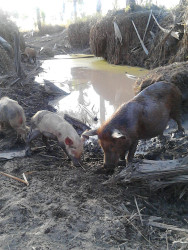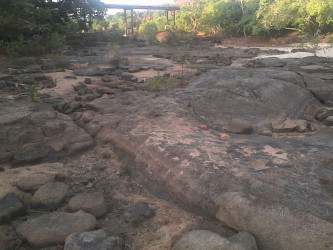Much of the supplies to help alleviate the drought baking the Rupununi are not reaching villages but are in storage in Lethem, residents have reported but Regional Executive Officer (REO) Carl Parker says the communities have to make requests to access the items.
“If we get requests from specific communities, we will respond,” Parker told Stabroek News yesterday. He related that supplies such as water purification tablets and pumps are at the response centre controlled by Region Nine vice-chairman Karl Singh and they have been waiting on requests from villages.
According to Parker, if villages realise that they are in trouble, they should make a request and he is sure that the regional authorities will respond. He said he did not think that any village will not cry out if they do not need the help. He said he had assisted one village which had requested assistance. He added that it is not the case that the authorities have enough supplies such as tanks and pumps to supply every village. For months, drought as a result of El Nino has been baking the Rupununi and the situation is worsening with crops dying, rivers and wells drying up, and livestock having to seek water from farther away, residents told Stabroek News.

Over the period, the authorities have said that they are responding to the situation. During a visit to several Rupununi villages in October, Minister of State Joseph Harmon had committed immediate support through the Civil Defence Commission (CDC) to ensure the provision of purification tablets, water tanks and other related materials to combat the effects of the season. He had also said that the building of a warehouse in Lethem for the storage of food and other needed items is actively being pursued. Harmon had assured the residents that the new administration will not neglect the communities, but will work assiduously to bring relief where needed.
However, residents from villages in the Deep South Rupununi told Stabroek News yesterday that the response has been minimal.

Aishalton resident Tony James told Stabroek News that his village has not benefited from water purification tablets, water tanks or other supplies. “The water situation is terrible,” he said while adding that on a steady basis, residents are working together to deepen their wells as the water table continues to fall.
There were a few, slight showers over the past two weeks but this was not enough, he said. James said that in creeks, there are only ponds in deep spots and persons are utilising these for washing and bathing but as the water does not flow, the ponds are becoming polluted and “not sanitary to bathe or wash in.”
He said that streams in farming areas in the forest are drying up as well making it difficult for farming activities to continue. In addition, James said, due to the low water levels in some bigger waterways, the fish are confined to ponds and persons are going to capture them and this could have implications for future supplies.
James said that there is need for a concerted effort to tackle the drought and in terms of supplies made available to alleviate the effects of the drought, he said they have not seen this as yet. Further, he said, officials need to visit for longer periods rather than spend a few hours.
In Karaudarnau, the situation was much the same. The Rupununi River has stopped flowing and water levels in the pools that remain as well as in hand-dug wells, continue to fall, Stabroek News was told.
“It is really affecting us now,” one resident said. She related that young cassava plants are drying out and the tubers are dry but persons are continuing to use it because they have nothing else.
“The river getting slimy…it low, low, low…you gotta look for clean spots to bathe,” she said. The resident related that the solar pump system is not functioning optimally and for the school’s hot meal programme, water has to be fetched from the lone working pump outside the compound.
She also noted that while officials from the Guyana Water Incorpora-ted (GWI) had visited, they spend very little time in the community. “They come but they only spending one hour or a few minutes,” she said, while adding that the problem with the pump was not solved. The resident said that no other officials have visited for this year and though a request was made for assistance in one assistance, there was no response. They had not seen any of the supplies said to be available for the drought-stricken region, she stressed.
The resident said that planting of crops has also been affected. “We waiting for a little rain…we did not plant because of no moisture in the soil,” she said. The few crops sown died out quickly due to the lack of water, she pointed out.
The resident said that livestock is also affected and are straying farther and farther away in search of water. She recalled that during the last drought, a few had died.





